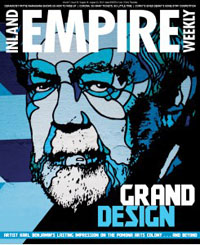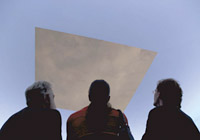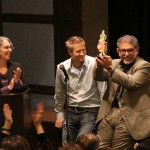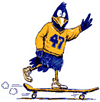 Just weeks after the influential painter’s passing, Karl Benjamin’s image can be found painted on a wall in the downtown Pomona Arts Colony. Renowned for his colorful abstract painting, Benjamin taught at Pomona College from 1979 to 1994, and his work is found in collections from the Los Angeles County Museum of Art to the Whitney Museum of American Art.
Just weeks after the influential painter’s passing, Karl Benjamin’s image can be found painted on a wall in the downtown Pomona Arts Colony. Renowned for his colorful abstract painting, Benjamin taught at Pomona College from 1979 to 1994, and his work is found in collections from the Los Angeles County Museum of Art to the Whitney Museum of American Art.
The new mural by David Flores was planned well before Benjamin’s death in July at age 86, and Flores completed it earlier this month. This news comes from an IE Weekly cover story written by Pomona’s very own Chris Michno (of the Financial Aid Office), who calls Benjamin an “artist’s artist.” Writes Michno:
Ironically, Karl Benjamin wasn’t concerned with celebrity; he was simply and resolutely committed to painting. He was engaged in a continuous structural arrangement of shape, color, pattern, space and rotation; he cared more for exploration than notoriety. Yet, his likeness appears on a wall in the Arts Colony. Pedestrians traversing the distance between venues will have ample time to consider the image before them as they pass through the west-end fringe of the Pomona Arts Walk along the row of businesses, studios and galleries. Perhaps some will stop to read the inscription painted on the corner of the mural. Those who know of Karl Benjamin will understand that his final admonishment would be for each one to sit quietly and start coloring.
More about Benjamin today in The Nation, and last month in The Huffington Post.

 The
The  And, in a
And, in a  The recent influx of culinary copyright and plagiarism cases—cookbook authors bickering about recipes, New York chefs suing each other over lobster rolls—reflects rising financial stakes in the industry. … The only way to figure out which inventions can be patented and which ones can’t is through trial and error. McDonald’s’ ‘toasting of a bread component?’ No, thanks. ‘Edible cardboard?’ Welcome to the club.”
The recent influx of culinary copyright and plagiarism cases—cookbook authors bickering about recipes, New York chefs suing each other over lobster rolls—reflects rising financial stakes in the industry. … The only way to figure out which inventions can be patented and which ones can’t is through trial and error. McDonald’s’ ‘toasting of a bread component?’ No, thanks. ‘Edible cardboard?’ Welcome to the club.” While visitors hung out and played old records from the station’s still-extensive collection, Tyron noted that some students find working with LPs a tad intimidating because of the direct contact with the surface of the record: “People just get nervous that you’re going to break something.”
While visitors hung out and played old records from the station’s still-extensive collection, Tyron noted that some students find working with LPs a tad intimidating because of the direct contact with the surface of the record: “People just get nervous that you’re going to break something.”


